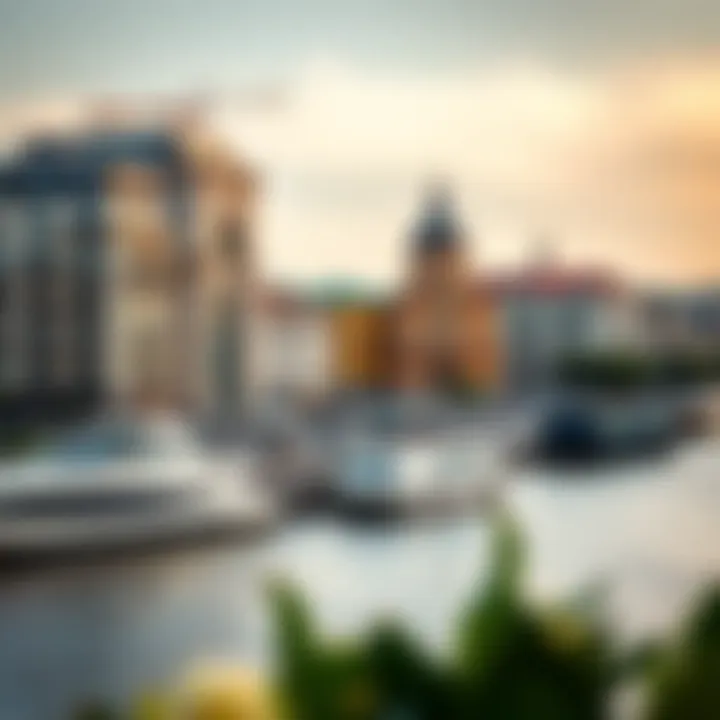The Elegance of the Danube: A Comprehensive Exploration


Intro
The Danube River, a mesmerizing ribbon of water flowing through central and eastern Europe, is not just a geographical feature; it embodies a rich tapestry of history, culture, and ecological diversity. Its elegance is found in the ways it shapes the lives of the communities that hug its banks. Each city and village along the Danube bears its own tale, adding layers to the landscape’s allure.
As one traverses this grand waterway, you begin to perceive the nuances that define its grace. From the bustling urban scenes of Vienna to the serene countryside of the Danube Delta, the river reflects a blend of natural beauty and human ingenuity. This exploration dives into how the Danube weighs heavy on the identity of the regions it traverses, playing an instrumental role not only in local economies but also in cultural expressions.
This article seeks to untangle the threads that tie elegance to the Danube, revealing its significance in literature, art, and beyond. As we navigate through its dimensions, we will discover the interconnections that contribute to its status as a celebrated and respected waterway.
By understanding the history and the modern-day implications of the Danube, we gain insights not just into the river itself but into the essence of the communities that thrive alongside it. The elegance of the Danube is, quite simply, the elegance of human experience intertwined with nature's profound beauty.
Stay tuned as we immerse ourselves in various aspects of this enchanting waterway, ensuring to appreciate the various layers that contribute to its elegance.
Preamble to the Danube's Elegance
The Danube River is much more than just a winding body of water cutting through Central and Eastern Europe; it symbolizes the richness of history, culture, and nature that defines the regions through which it flows. Understanding the elegance of the Danube involves exploring its multifaceted role in shaping identities and influencing lifestyles along its banks. It carries with it a tapestry of human experiences—each thread woven into the fabric of the surrounding communities.
Historical Context of the Danube
The history of the Danube is long and layered, as it has been a vital artery for trade, migration, and cultural exchange for thousands of years. Initially serving as a natural border of the Roman Empire, the river has been the epicenter of countless historical events. For instance, the Danube was pivotal during the Celtic, Roman, and Byzantine eras, showcasing its importance as a strategic point of contact between diverse civilizations.
Moreover, its banks have witnessed the rise and fall of empires: from the Roman fortifications built along its shores to the bustling trade routes established during the Middle Ages. This river, with its deep currents and serene landscapes, has shaped the socio-political dynamics of the region, creating a legacy that continues to impact contemporary issues. Even in modern times, the Danube remains a key player in politics and commerce, emphasizing its ongoing relevance in a fast-paced world.
Cultural Resonance
The cultural significance of the Danube is palpable, echoing through the literature, music, and visual arts that it has inspired. Writers like Franz Kafka and Mark Twain have drawn from the river's elegance, capturing its essence in prose that whispers the deep connection between the land and its people.
Similarly, the Danube has been immortalized in countless musical compositions, perhaps most famously in Johann Strauss II's "The Blue Danube." This waltz reflects not only the beauty of the river but also the exuberance it embodies in the celebrations and festivals that transpire along its banks.
In recent years, the Danube's cultural presence has expanded to include vibrant forms of modern art, where artists seek to reinterpret its beauty through innovative lenses. From murals celebrating local culture to exhibitions discussing ecological issues, the river inspires a diverse array of artistic expressions, each adding another layer to its narrative.
Overall, the Danube is not merely a waterway; it is a living entity that continues to foster community, culture, and creativity, making it a subject worthy of deep exploration.
"The Danube is a river that connects more than just lands; it intertwines histories, cultures, and aspirations of millions."
As we embark on this exploration, we will dissect further elements that showcase the Danube's elegance, shedding light on aspects that contribute to its captivating allure.
Geographical Overview
The Danube River is not just a geographical feature; it is a lifeline for many regions it touches. Its winding journey through various landscapes adds layers of elegance and complexity to the narratives of the places it traverses. Understanding the geographical overview of the Danube provides essential insight into how this river influences the culture, economy, and environment of surrounding areas. It acts as a natural boundary between countries, a source of inspiration for artists, and a historical route for commerce and communication.
The Course of the Danube
The Danube begins its long voyage in the Black Forest of Germany, cutting a path through Central and Eastern Europe over approximately 2,860 kilometers before it empties into the Black Sea. This river wends its way through a diverse array of terrains, including mountains, flat plains, and bustling urban centers. Each bend and turn of the river reveals unique geographical features that contribute to its majestic allure.
- Source: The river starts near Donaueschingen, on the confluence of the Brigach and Breg rivers.
- Major Bends: Notable curves like the Iron Gates create dramatic topography and scenic views.
- Tributaries: Some noteworthy tributaries, such as the Inn and the Morava, enhance its ecological richness.
What sets the Danube apart from other rivers is its capacity to mold the culture and economy of the territories through which it flows. Countries such as Austria, Hungary, and Romania showcase their distinctive identities shaped by the river. In this sense, the Danube is more than just a waterway; it's a narrative thread connecting historical contexts and regional cultures.
Important Cities Along the Danube
As the Danube flows through multiple cities, each location reveals a unique facet of the river's beauty and significance. Major urban centers along its banks serve as cultural and economic hubs that connect the people to both their heritage and the river. Cities like Vienna, Budapest, and Belgrade provide a rich tapestry of history and modernity intertwined.
- Vienna: Austria's capital, known for its stunning architecture and vibrant cultural scene. The Danube here acts as a backdrop for numerous events and festivals.
- Budapest: Often dubbed the "Pearl of the Danube", this city is famous for its thermal baths and stunning cityscape as viewed from the Danube. It hosts the annual Danube Carnival, blending music, dance, and food.
- Belgrade: The confluence of the Sava River and the Danube provides a fascinating historical perspective to this city, offering a glimpse into Serbia's rich past.
The importance of these cities is not just topographical; they are gateways to understanding how the river influences regional lifestyles. Each city’s architectural beauty and cultural contributions underscore the river's role in shaping their identities.
"The Danube is not merely a geographical feature; it is an emblem of shared history and collective aspirations of the nations it touches, weaving together as varied a fabric as the cultures along its banks."
Understanding the Danube's geographical overview, including its course and the cities it embraces, enables a holistic view of how this liquid artery plays a vital role in the elegance and vitality of the regions around it.
Nature and Biodiversity
The Danube River is a significant ecological corridor that threads through multiple countries in Europe. Spanning an impressive 2,860 kilometers, its banks are home to a rich variety of flora and fauna. Understanding the nature and biodiversity of the Danube is not just about celebrating its beauty; it's also crucial for grasping the interconnectedness of ecosystems and the importance of conserving this vital resource.
Ecological Significance
The Danube serves as a lifeline for numerous species, including over 100 species of fish and various migratory birds that stop along this route during seasons. The river’s wetlands are not merely charming; they are crucial in maintaining the ecosystem. These areas filter water, provide habitats, and support an elaborate food chain.
For instance, when the river swells, it floods its adjacent floodplains, resulting in fertile grounds that nurture countless plant species. This naturally leads to a more diverse animal population, as these rich environments provide shelter and food. Moreover, some unique species that exist nowhere else on the planet can be found here, such as the Danube River snail.
Understanding the ecological significance of the river goes beyond just counting species; it’s about recognizing that the health of the Danube reflects the health of the entire region. As the river flows through densely populated areas, its demand for space to thrive faces fierce competition from urban development and agriculture.


“A river’s life is a tapestry woven with threads of existence, and the Danube is no different.”
Conservation Efforts
Given the Danube's rich biodiversity, concerted conservation efforts are paramount. Over the years, several international agreements and initiatives have aimed to safeguard the river’s ecological integrity. Initiatives such as the Danube Strategy and the Transnational Cooperation Program work closely with governments, organizations, and local communities to promote sustainable development.
Some noteworthy actions include:
- Restoration of wetlands to improve water quality and restore natural habitats.
- Monitoring of pollution levels and wildlife populations to ensure that species can thrive.
- Engaging local communities in conservation efforts, encouraging people to take an active role in protecting their natural resources.
The promotion of biodiversity is not just an environmental issue; it also carries economic implications for the regions through which the Danube flows. Maintaining healthy and diverse ecosystems attracts tourists, supports fisheries, and contributes to local agriculture.
In closing, the nature and biodiversity along the Danube reflect a rich tapestry of life. Yet, this vibrant natural heritage needs vigilant stewardship. The continuity of both species and local economies hinges on our committed efforts to maintain the delicate balance of this fascinating river. By understanding and valuing the ecological significance and ongoing conservation efforts, stakeholders can help ensure that the Danube's beauty endures for generations to come.
Artistic Representation
Art has a unique way of encapsulating the essence of environments, experiences, and emotions. When it comes to the Danube, artistic representations serve as a critical bridge between the river’s physical presence and its deeper significance. Through literature and visual arts, artists and writers have captured not just the scenic beauty of the river, but the emotions and stories woven into its currents. The Danube has inspired countless works that reflect cultural identities, historical narratives, and ecological mindfulness, underscoring its elegance across various art forms. These representations not only celebrate the river itself but also highlight the intricate relationship between nature and human creativity.
Literature Inspired by the Danube
The Danube has been a muse for many authors and poets throughout history. From the flowing lines of verses to the intricate plots of novels, the river's banks provide fertile ground for storytelling. Writers such as Julius Meinl and Robert Musil have drawn from the river's beauty, crafting tales that resonate with both locals and tourists alike.
A significant aspect of literature inspired by the Danube is its ability to evoke a sense of place. Take **
The Danube in Music
The Danube River, with its sinuous path and profound historical significance, has long captured the hearts and minds of composers and musicians. It serves not just as a geographical feature but as a Muse that evokes a plethora of emotions and ideas. Music inspired by the Danube provides insight into the river's beauty and cultural heritage, revealing how it weaves through the tapestry of European culture.
Classical Compositions
In the realm of classical music, the Danube's influence is both rich and diverse. Iconic pieces that celebrate this majestic river have emerged throughout the ages, blending nationalistic motifs with lyrical melodies. A standout example is Johann Strauss II's waltz, “The Blue Danube” (An der schönen blauen Donau). Composed in 1867, this piece encapsulates the romance of the river, transporting listeners to the banks of the Danube with its graceful rhythms—the very sound of elegance that permeates the river's surroundings.
Additionally, composers like Antonin Dvořák and Bedřich Smetana have drawn on the Danube in their works, contributing to the river’s musical legacy. Dvořák’s “Slavonic Dances” and Smetana’s “Má vlast” cycle reflect not just the natural scenery but also the spirit of the nations that the Danube nurtured. This music connects the listener to the very essence of Central Europe, where cultural exchanges occur as naturally as the river flows.
“The river sings the history of the lands it nourishes, a chorus of human experience and nature's grace.”
In short, classical compositions celebrating the Danube are more than mere music; they are historical artifacts that convey stories, movements, and the very pulse of life along its banks.
Contemporary Interpretations
Moving into contemporary times, modern artists continue to draw inspiration from the Danube, often incorporating a wider array of genres and styles. For instance, you might stumble upon the work of the German band 17 Hippies, whose song “Danube” reflects a fusion of folk and rock, celebrating the river not just as a physical entity but as a cultural spirit that connects people across borders.
Electronic music has also embraced the allure of the Danube, with artists using the river's sounds to craft ambient and travel-inspired tracks. This innovation showcases how the centuries-old river continues to influence the sound of modern music, making it relevant to new generations of listeners.
From classical to contemporary, the Danube serves as a powerful muse. The evolving relationship between the river and its musical interpretations exhibits not just a continuity of cultural significance but also its role in expressing the complexities of life along its banks. Whether in orchestral halls or intimate cafes, the music of the Danube remains a vital thread in the fabric of artistic expression across Europe.
Throughout these interpretations, the river continues to inspire and resonate, reminding all of the beauty and depth contained within its waters and the shared heritage it represents.
A Culinary Journey along the Danube
Exploring the Danube River's elegance naturally encompasses its rich culinary tapestry. Food along this storied waterway serves not only as sustenance but also as a cultural touchstone. It provides insights into the customs, traditions, and identities of the nations it flows through. The culinary journey is about discovering flavors, techniques, and tales from various regions, each adding to the allure of this majestic river.
Traditional Dishes and Regional Flavors
The Danube's culinary landscape reflects its diversity, showcasing traditional dishes that vary significantly from one area to another. In Germany, for example, locals savor hearty meals like Sauerbraten, a pot roast that embodies rustic flavors steeped in vinegar and spices. Meanwhile, as the river snakes into Austria, no visit is complete without indulging in a slice of Sachertorte, a rich chocolate cake that tells the story of Vienna’s patisserie culture.
Further downstream in Hungary, Gulyás, a piquant goulash made with meat and vegetables, springs forth from a rich history of Magyar hospitality. This dish isn't just lunch; it’s a warm invitation to experience the vibrant community that surrounds it. Each bite carries echoes of family gatherings, reminding one of the communal spirit that defines Hungarian culture.
In Romania, you might find Sarmale, cabbage rolls filled with minced meat and rice, each roll lovingly wrapped by hands that have passed down the recipe through generations. These dishes not only satisfy hunger; they unify locals and travelers alike, creating shared experiences along the banks of the Danube.
Influence of the Danube on Cuisine
The Danube's influence extends beyond regional dishes; it has shaped the entire culinary landscape of the area. This river serves as a major trade route, enabling the cross-pollination of ingredients, cooking styles, and flavors. Spices from the east mingle with the hearty meats and grains of the west. As trade flourished, so did culinary experimentation.
"The culinary significance of the Danube is profound—it’s more than just a river; it’s a lifeline of flavors and traditions that nourish both body and soul."
Additionally, festivals celebrating the Danube bring local chefs and food artisans together, presenting an opportunity for them to showcase their craft. Events such as the Danube Wine Festival in Serbia celebrate varietals unique to the region, uniting growers and wine enthusiasts. Here, both locals and visitors can taste and appreciate the labor of love that goes into every bottle. This ongoing dialogue of flavors is not merely a culinary exchange; it’s a celebration of shared identity.
The Danube aptly illustrates how a body of water can shape cuisines and culinary traditions, with each city along its banks offering a unique taste of its heritage. The food does not simply sustain; it tells stories, forges connections, and helps preserve collective memory, inviting all who encounter it to savor life's richness.
Tourism and Elegance


Tourism along the Danube River offers a unique opportunity, reflecting a blend of natural beauty and cultural richness. The elegance of this majestic river draws millions of visitors each year, all eager to explore its winding paths that crisscross through several countries. This section discusses the significant elements of tourism that enhance the charm of the Danube, focusing on the experiences it provides, the benefits for local economies, and the considerations tourists must take into account.
River Cruises: A Unique Perspective
River cruises on the Danube stand out as one of the most enticing ways to experience the river. Unlike traditional land-based tourism, being on a river cruise allows one to soak in serene landscapes and picturesque towns only visible from the water.
These cruises often stop at several historic cities such as Vienna, Bratislava, and Budapest, offering passengers the chance to disembark and immerse themselves in local cultures. Travelers can witness the elegance of these cities transition from ancient castles to modern architecture, all while surrounded by the calming flow of water.
"Experiencing the sunset over the Danube from a riverboat is nothing short of magical—a sight that stays with you long after."
However, it is essential for tourists to consider the environmental impact of such tourism. River cruises can bring in significant revenue, yet they also leave ecological footprints. Sustainable cruise lines are rising to the challenge, utilizing eco-friendly practices to mitigate these impacts while ensuring that travelers enjoy the elegance of the Danube responsibly.
Heritage Sites along the Danube
The Danube is not just a river; it is a conduit of history, with numerous heritage sites dotting its banks. These sites serve as windows into the past, showcasing the cultural evolution marked by centuries of human activity.
- Some prominent heritage sites include:
- The Belvedere Palace in Vienna, an exquisite display of Baroque architecture.
- The Buda Castle in Budapest, which tells tales of the medieval past.
- The Czech city of Český Krumlov, famed for its well-preserved medieval core.
Each site offers insights into the regional identity shaped by the Danube, enhancing its elegance. Tourists seeking to explore these landmarks can benefit from guided tours that delve deeper into the significance of each location, enriching their understanding of the river's impact on local culture and history. Moreover, many sites host annual events and festivals that celebrate their history, attracting visitors looking to engage with local communities and traditions.
In essence, the tourism landscape along the Danube showcases the river's dual nature—its elegance brings forth both economic opportunities and a call to preserve and respect the rich tapestry of history it embodies.
The Danube's Role in Trade and Economy
The Danube River plays a crucial role in shaping economic activities and trade connections across various nations in Europe. It serves as a vital artery for transporting goods and services, linking diverse cultures and economies. By traversing through ten countries from Germany to Romania, the river not only enables efficient movement of cargo but also fosters economic growth and regional collaboration. The nuances of the Danube's economic influence span from historical trade routes to the modern-day logistics of commerce, making it an essential topic in understanding the river's elegance.
Historical Significance in Commerce
Historically, the Danube was the lifeblood of trade in Europe. During the Roman Empire, it was instrumental in the movement of armies, grain, and other essentials across borders. Cities like Vienna and Budapest thrived due to their strategic locations along the river. This position allowed merchants to capitalize on trade flows.
Key historical facts include:
- Ancient Trade Routes: The river has long served as a trade corridor facilitating exchanges between the East and the West, notably from the Byzantine trading posts in the south to the Germanic tribes in the north.
- Fluvial Transport: Before the development of railways, the Danube was the most efficient transport mode. Goods were ferried on boats that made their way through the winding waters, connecting various riparian states.
- Market Towns Emergence: Towns along the river became bustling market hubs, where merchants from different cultures would convene, sharing not just goods but also ideas.
The historical significance lies not only in the materials traded but also in the forging of connections among civilizations. Over centuries, the river has produced a rich tapestry of commerce that continues to resonate today.
Current Economic Impact
Fast forward to present times, the economic impact of the Danube remains significant. As an international shipping route, it supports numerous industries and contributes substantially to the economies of riparian countries. Consider the following facets:
- Shipping and Transportation: The river serves as a conduit for bulky materials like coal, grain, and metals, optimizing logistical costs. Large cargo vessels navigate its waters, ensuring that trade remains competitive and efficient.
- Tourism Industry: The Danube's natural beauty and historical significance attract millions of tourists annually. River cruises and cultural tours are booming, contributing significantly to local economies and creating jobs.
- Sustainability and Future Growth: A growing emphasis on sustainable practices is evident in the shipping sector, leading to innovations in eco-friendly transport. Many countries are investing in infrastructure improvements to enhance navigation and minimize environmental footprints.
The current economic impact of the Danube portrays a river not just as a body of water but as an essential element that ties together Europe’s economic fabric.
"The Danube is more than a geographical feature; it's a lifeline fostering trade and community among nations."
Social and Community Influence
The Danube River is not merely a geographical feature; it acts as a lifeblood for the communities that line its banks. The river fosters strong connections among local populations, enriching social interaction and cultural identity. Festivals, celebrations, and traditions linked to the Danube play a pivotal role in enhancing community spirit, bringing together people from various backgrounds to share in the beauty and legacy of this remarkable waterway.
Festivals Celebrating the Danube
Festivals along the Danube serve as vibrant expressions of local culture, often centered around seasonal events or historical significance. For instance, the Danube Carnival held in cities like Vienna and Budapest attracts both locals and tourists. This festival showcases a delightful array of folk music, art, and hearty cuisine, all revolving around the themes of community and unity.
Another noteworthy event is the Danube Day, celebrated every year on June 29. This initiative aims to raise awareness about waterway conservation while marking the cultural heritage tied to the river. Communities often come together to participate in activities ranging from clean-up campaigns to educational workshops, fostering a collective responsibility and admiration for the river’s ecosystem.
- Danube Carnival: Folk music, art, and foods celebrating local traditions.
- Danube Day: Activities focused on conservation and community involvement.
These events are not only occasions for festivity but also critical platforms for dialogue about environmental responsibility and regional cooperation.
Local Communities and the River
Local communities depend heavily on the Danube for sustenance and cultural expressions. Many towns observe traditional fishing practices and engage in tourism based on the river’s scenic beauty. The picturesque towns of Regensburg and Dürnstein showcase charming architecture alongside thriving local economies reliant on the inflow of visitors drawn to the river's elegance.
In the Slovak capital of Bratislava, you’ll find several community initiatives aimed at promoting the Danube's significance. Residents often participate in river clean-up operations, educational programs, and art projects designed to highlight the river's elegance. This involvement fosters a sense of ownership among locals, as they realize their role in preserving a vital natural resource.
"The river does not just flow through our city; it flows through our lives, connecting us all."
Furthermore, many schools along the Danube incorporate river studies into their curricula, educating younger generations about the ecological and historical importance of this waterway. Shrinking fish populations and pollution issues necessitate that communities take proactive measures, ensuring that the Danube remains a source of pride and utility for years to come.


In summary, the Danube defines social frameworks in surrounding communities. Through vibrant festivals and local initiatives focused on conservation and education, it significantly enhances social cohesion, cultural identity, and environmental awareness.
For further reading on these topics, resources are available through Wikipedia and Britannica.
Challenges Facing the Danube
The Danube River, remarkable and majestic as it may be, faces a myriad of challenges that threaten its splendor and significance. By delving into these challenges, we uncover the vulnerabilities that have far-reaching implications not just for the river, but for the cities and communities that rely on it. Understanding these threats helps paint a fuller picture of the Danube's elegance amidst a backdrop of environmental degradation and socio-political strife.
Environmental Threats
The ecological health of the Danube is under siege. Various factors contribute to this predicament, including pollution, damming, and climate change. Here are some of the key environmental issues that need addressing:
- Pollution: Industrial runoff and agricultural chemicals flow into the river, compromising its water quality. Toxic substances not only harm aquatic life but also impact drinking water sources for millions of inhabitants along its banks.
- Damming and River Alterations: The construction of dams alters the natural flow of the river, impacting fish migration and disrupting the delicate balance of the ecosystem. For example, the Iron Gates Dam significantly changed local habitats, affecting both biodiversity and natural sediment transport.
- Invasive Species: The introduction of non-native species has caused imbalances in local ecosystems. Species like the zebra mussel outcompete native organisms for resources, leading to a decline in local biodiversity.
"Protecting the Danube is not just about conserving a river; it’s about preserving a lifeline for communities, economies, and ecosystems across Europe."
These environmental issues illustrate the urgent need for concerted conservation efforts. Without addressing such challenges, the elegance of the Danube will continue to fade, diminishing its role as a vital waterway.
Political and Economic Struggles
The political landscape surrounding the Danube is as intricate as the river’s winding path. Multiple countries share its waters, each with their interests and policies. This can lead to conflicts and ineffective management of the river's resources. Key factors in this struggle include:
- Cross-Border Governance: Discrepancies in environmental regulations and water management between nations often lead to ineffective conservation efforts. A lack of cohesive policies makes it challenging to tackle pollution and resource allocation effectively.
- Economic Development vs. Conservation: Many regions bordering the Danube are economically dependent on river-based activities like shipping, tourism, and agriculture. This reliance can lead to prioritizing short-term economic gains over long-term ecological health. Balancing such needs requires sophisticated policymaking and diplomacy.
- Funding Challenges: Environmental projects often seek financing from governments and NGOs. However, with competing interests and pressing local needs, securing appropriate funding can be more difficult than navigating the river itself.
Tackling these political and economic struggles is paramount for ensuring the Danube's sustainability. The stakes are high, affecting not just the river's ecology but also the individual communities and economies that thrive along its banks. Only through collaboration and diligence can we hope to maintain the river's grandeur and importance into the future.
Conservation Efforts and Future Outlook
The charm and sophistication of the Danube River come not just from its historical and cultural significances but also from the urgent necessity of conservation efforts. The truth is, as beautiful as the Danube is, it faces a multitude of threats that can (and do) undermine its allure. Pollution, climate change, and rampant urbanization present challenges that could steer this grand waterway toward a less pleasant future. Therefore, understanding both the landscape of current conservation initiatives and future strategies for sustainable development is crucial for ensuring that the elegance of the Danube endures for generations to come.
Collaborative International Initiatives
When nations unite for a common cause, remarkable change can manifest. One shining example of this collaboration is the International Commission for the Protection of the Danube River (ICPDR). Established in 1998, this group facilitates cooperation among the Danube Basin countries to improve the quality of its waters, safeguard biodiversity, and manage resources better. The ICPDR's work emphasizes the importance of collective action and provides a clear illustration of how neighboring nations can work together.
To highlight the significance of these initiatives, consider the following key actions taken by the ICPDR:
- Joint Monitoring Programs: Countries share resources and data to ensure consistent oversight of the river’s health.
- Flood Risk Management: A concerted effort among countries focuses on mitigating flood risks that can devastate communities.
- Awareness Campaigns: Engaging local populations is critical. Campaigns about waste disposal and chemical runoff help instill a sense of responsibility.
The impact of collective actions is tangible. Not only do they promote ecological stability, but they also build a framework for long-term cultural ties among the nations situated along the river. As stated by ICPDR, “Sustainable development is not a goal; it’s a process that continues to evolve.” This process is vital for maintaining what makes the Danube an object of elegance.
Plans for Sustainable Development
The future of the Danube hinges not only on protective measures but also on proactive sustainability plans. These plans must be well-rounded, involving a balance of ecological, economic, and social considerations. One of the critical aspects is developing a "Green Infrastructure" approach, which integrates nature-based solutions into urban planning. It allows cities along the Danube to manage stormwater more effectively while enhancing urban green spaces. These benefits foster improved quality of life for residents and help mitigate urban heat island effects—where cities become noticeably warmer than surrounding areas due to human activities.
Moreover, a transparent and inclusive framework in policy-making can drive sustainable outcomes. Involving local communities in decisions ensures that those who interact with the river daily have a voice in strategies impacting their environment. People’s connections to the Danube can transform from mere passive observation to active stewardship.
Consider these aspects in a sustainable development plan:
- Reduced Pollution: Setting stricter regulations on industrial waste disposal into the river can drastically improve water quality.
- Biodiversity Enhancements: Initiatives that create wildlife corridors can help the river's diverse species thrive again.
- Community Engagement: Workshops and educational programs about environmental conservation can lead to more robust local participation.
In summary, the elegance of the Danube, enriched by its historical charm and cultural significance, is at a crossroads. Collaborative international initiatives and well-thought-out sustainability plans must intersect to ensure that this waterway not only remains a natural treasure but continues to thrive as an emblem of grace and resilience in the face of adversity.
"The health of the Danube can be seen as a reflection of the well-being of its communities. When we care for the river, we care for ourselves."
Being proactive isn't just good stewardship; it is an investment in the river’s future, which benefits all stakeholders—whether they be investors, community leaders, or simply lovers of nature.
Closure: The Lasting Influence of the Danube's Elegance
As we draw the curtain on our exploration of the Danube, it's clear this river is more than just a body of water; it serves as a lifeline, weaving through the very fabric of European history and culture. The Danube's elegance resonates profoundly through its interplay of nature, community, and heritage. The significant influence it holds is both temporal and timeless, impacting generations and shaping identities.
One undeniable aspect is its historical significance. Over centuries, the Danube has acted not just as a boundary but as a bridge connecting various cultures. It has witnessed the rise and fall of empires. There's something poetic about how this river has been at the heart of historical dialogues, making it a witness to the collective human experience.
When we think about cultural implications, the river emerges as a symbol in literature and arts. Writers like Joseph Roth and artists like Gustav Klimt have drawn inspiration from its meandering path, showcasing the depth of cultural resonance. The Danube isn't merely a backdrop; it's a character in stories told and retold, reminding us of our shared narratives.
Economically, the importance of the Danube cannot be overlooked. It facilitates trade and tourism, vital for regional economies. Cities like Vienna and Budapest thrive on the commerce fostered by this elegant river, bringing together diverse populations and ideas. Each year, countless tourists flock to its banks, drawn by its beauty and the vibrant cultures it supports.
Furthermore, from an ecological perspective, the Danube offers a rich tapestry of biodiversity. The ongoing conservation efforts speak volumes about the commitment to preserving not just a river but a precious lifeline for many species and communities. This commitment is a legacy that future generations will inherit, underlining the need for sustainable practices as we move forward.
"The Danube is not only a river—it is a journey through time and a continuum of stories that bind cultures together."
So, as we reflect on the legacy of the Danube, let us not merely admire its elegance but strive to understand and preserve the influence it holds, ensuring its tales endure for generations to come.
For further information, you might find these links helpful:
- Wikipedia: Danube River
- Britannica: Danube
- Reddit: Discussing the Danube
- Government Resources
- Educational Insights
As we conclude this journey, it’s vital to remember that just like the flow of the river, the elegance of the Danube continues, shaping lives and inspiring souls across landscapes.











